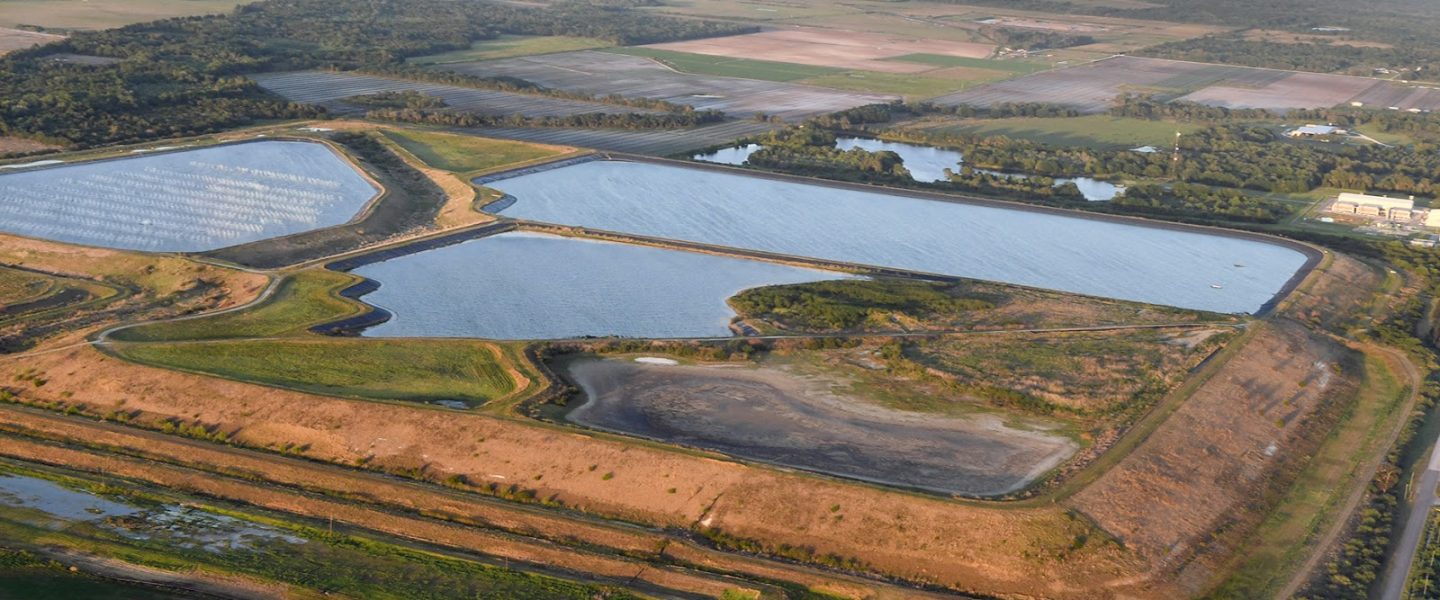A toxic reservoir in Florida nearly burst this month, sending a wall of radioactive water towards homes and businesses. The state let it happen.
During a hastily assembled press conference on Easter Sunday, Ron DeSantis, the Republican governor of Florida, leaned into the microphone to criticize a hedge fund.
An enormous, privately owned reservoir at a decommissioned fertilizer plant was leaking and at risk of collapse. If it breached, more than 400 million gallons of mildly radioactive, highly toxic water could rush towards homes, businesses, and Tampa Bay.
“This is not acceptable. This is not something we will allow to persist,” said the governor, who vowed “full enforcement” against HRK Holdings, which had purchased the property in Piney Point in 2006 and used the reservoirs to store dredging waste scraped from the bay floor from nearby Port Manatee.
But HRK had declared bankruptcy after another leak in 2011 — one of at least three major discharges from the toxic reservoir since the fertilizer plant closed in 2001.
How Florida would manage to pursue a case against an allegedly broke corporate entity, DeSantis did not say. “We’ll never get a nickel out of them,” Manatee County Commissioner Kevin Van Ostenbridge later told the Miami Herald.
In the meantime, the bill to repair the reservoir and prevent future catastrophe will be footed by taxpayers. The Florida state Senate is moving to use $200 million from President Biden’s stimulus plan to shore up Piney Point, which is just one of 25 such sites located around Florida.
The sight of a Trump Republican governor lambasting irresponsible private enterprise — while eagerly accepting federal help from a Democratic administration — breaks the typical partisan narrative.
But according to critics, it’s also an exercise in cynical misdirection.
It was the state Department of Environmental Protection that ignored clear direction from the US Army Corps of Engineers not to allow HRK to stash dredge waste in the Piney Point reservoir — a scenario the Corps warned could lead to a breach like the one that followed in 2011, documents show.
It was the Florida DEP that allowed another near-disaster at a site similar to Piney Point to go unpunished aside from a superficial fine levied against a corporation with annual revenues of close to $9 billion, according to a 2016 consent decree. And it’s the state that is entertaining proposals to expand other sites like this elsewhere in Florida.
Reached by telephone, a spokesperson from the state DEP did not immediately comment to WhoWhatWhy. Subsequent emails sent to the DEP were not returned by publication time.
But environmental watchdogs believe DeSantis is underplaying his state’s role in the crisis — and setting the stage for an inevitable repeat.
“This is a particularly egregious example of regulatory mismanagement,” said Jacklyn Lopez, the Florida state director for the Center for Biological Diversity. “Piney Point is a particularly graphic, well-documented example of industrial and regulatory failures. But it is not by any stretch an anomaly.”

The toxic reservoir at Piney Point sits on top of a gigantic pile of phosphogypsum. A vital link in the global food supply chain, phosphate mining and subsequent processing into fertilizer is a key driver of the economy in central Florida, nicknamed the “Bone Valley” for its nutrient-rich deposits of ancient fossils. After phosphate rock is dissolved in an acidic solution of water, what’s left over — in addition to the water, which is stored in lined reservoirs like the one at Piney Point — are “stacks” of phosphogypsum.
Phosphogypsum is mildly radioactive and laden with toxic heavy metals. With few uses — the Trump-era Environmental Protection Agency approved putting phosphogypsum in road projects — and nowhere to store it, enormous stacks of gypsum up to hundreds of feet tall and spanning hundreds of acres simply sit there in perpetuity, courting disaster.
Along with Piney Point — which began phosphate mining and fertilizer production in 1966 and ceased operations in 2001 — there are 24 other “gypstacks” located in central Florida.
Sixteen of them, including all three currently active, are owned by Mosaic Fertilizer LLC, a subsidiary of the Mosaic Company, the country’s largest fertilizer corporation. There are nearly 1 billion tons of phosphogypsum in these stacks — another 30 million is added each year.
“They’re the result of massive greed, nothing more than that,” said Jerry Phillips, executive director of the Florida chapter of Public Employees for Environmental Responsibility.
“The Department of Agriculture has bent over backwards to placate the fertilizer industry in Florida for decades,” he added. “And consequently, this type of thing has been allowed to grow.”
“The worst case scenario for Piney Point being used as a dredged material disposal facility would be a breach in the liner,” the USACE predicted. “The addition of dredged material … will increase the probability of contaminating the surrounding surface and groundwater.”
Critics, including the Sierra Club and the Center for Biological Diversity, say the state has allowed fertilizer companies and gypstack owners to do as they please, with little to no accountability even after environmental disasters.
Fertilizer producer Mulberry Corp. abandoned Piney Point in 2001 and declared bankruptcy shortly thereafter. After the state of Florida paid $144 million to partially clean the site, as the Herald-Tribune reported, HRK Holdings’s principal, a hedge fund manager named William Harley III, purchased the site in 2006 for $4.6 million.
HRK’s moneymaking plan for Piney Point, located a short drive from the ship terminal at Port Manatee, was to store dredging waste from a harbor expansion project.
According to public records, as early as 2008, the state DEP signed off on the plan to pile dredging waste on top of the Piney Point gypstack despite opposition from the US Army Corps of Engineers, which warned of a “heightened level of concern with regard to the integrity of the gypsum stack.”
“The worst case scenario for Piney Point being used as a dredged material disposal facility would be a breach in the liner,” the USACE predicted. “The addition of dredged material … will increase the probability of contaminating the surrounding surface and groundwater.”
That’s what happened in 2011, when the “protective lining” at one of the reservoirs at Piney Point breached after “several hundred million gallons of dredge material” was dumped there, as the Herald-Tribune reported. About 170 million gallons of wastewater spilled into Tampa Bay from the gypstack, according to WUSF Public Media.
Rather than pay for the cleanup, HRK declared bankruptcy.
The state has also allowed other companies to escape serious penalties for problems at gypstacks.
In 2016, a sinkhole appeared in one of the gypstacks at Mosaic’s New Wales phosphate plant. The breach took two years to plug and dumped 215 million gallons of toxic water into the Floridan Aquifer.
Rather than punish Mosaic, which recorded revenue of nearly $9 billion in 2020, the state absolved the company of wrongdoing. According to a settlement agreement reached between Mosaic and the DEP, the state “determined that the sinkhole was the result of circumstances beyond the control” of the company. “Therefore, the Department is not seeking civil penalties” despite identifying two potential violations.
“That’s legally nonsensical,” said PEER’s Phillips. “There’s not much other way to put it. That’s the extent they [DEP] went out on a limb to protect this phosphate company.”
Despite the sinkhole imbroglio, Polk County authorities in 2014 approved Mosaic’s plan to expand the New Wales gypstack by another 230 acres.
That plan could be finalized as soon as this summer, the Ledger reported.
On April 7, a few days after DeSantis lifted an evacuation order for more than 300 homes and reopened nearby US Route 41, Zory Sanchez, an environmental compliance technician with HRK Holdings, told the DEP that the Piney Point gypstack might still be leaking. The company had discovered three “active boils,” or upwellings of water, on the eastern side of the gypstack.
As of April 9, only one remained, Sanchez reported, but the boil revelations suggest Piney Point is still in unstable condition, according to Lopez of the Center for Biological Diversity.
And no matter what, taxpayers appear to be left holding the bag.
“Using stimulus money to pay for a regulatory failure that was foreseeable is a bad move as a matter of government,” she said. “If DEP intends to hold these folks culpable, then they need to do that immediately. Any money taken from the taxpayer must be borrowed — they better be paying that back.”
Regardless, for allowing HRK to store dredge waste at Piney Point, and for lax regulation and light punishment of Mosaic for its trouble at New Wales, “I absolutely think DEP is culpable here,” she said.
This time around, Florida dodged the worst-case outcome at Piney Point, but “success” came with an environmental cost: it required pumping more than 215 million gallons of toxic water out of the at-risk reservoir and into the only receptacle available: Tampa Bay. Rich in plant-friendly nutrients like nitrogen, the wastewater will almost certainly trigger an enormous bloom of algae, spelling doom for thousands and thousands of fish, environmental watchdogs believe.
Just like what happened in 2011, the most recent time the Piney Point gypstack leaked — but not likely to be the last.
“This particular environmental crisis is not over,” Lopez added. “And the bigger picture is that phosphogypsum stacks continue to grow, the fertilizer industry is expanding by at least 30 million tons of phosphogypsum a year, and we don’t even know how to manage the toxic waste we have.”
Related front page panorama photo credit: Adapted by WhoWhatWhy from Domantas Kancleris / Wikimedia (CC BY-SA 4.0).



